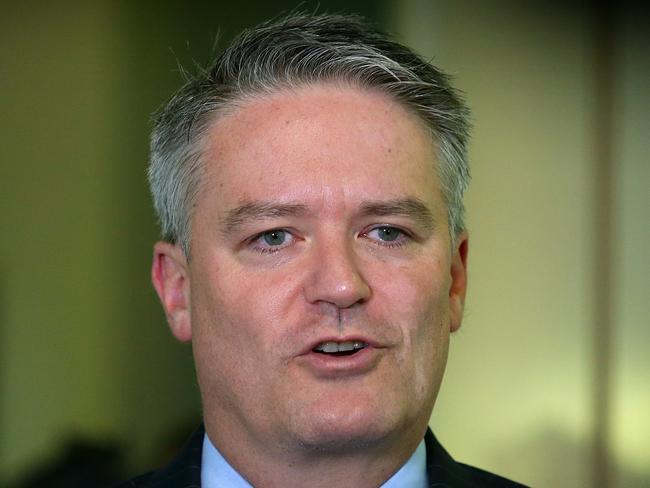Labor plan to scrap a little-known tax rebate would hit weathly investors, self-funded retirees and save $59 billion
LABOR’S plan to scrap a little-known tax rebate could save $59 billion but has been branded a “cruel slug”. Here is what it means.
National
Don't miss out on the headlines from National. Followed categories will be added to My News.
IT IS a tax lurk few Australians have heard of let alone exploited and today it became the centre of the economic debate to decide the election next year.
And it revolves around measures to ensure shareholders are not subjected to double taxation on their dividends.
The Government called a new Labor policy to abolish a cash rebate for shareholders who pay little or no tax, a “cruel slug” on seniors receiving a pension and a class warfare assault on self-funded superannuants.
Top economic ministers were mobilised by the Government to accuse Labor of wanting to rob voters of tax refunds, similar to those many PAYE workers received if their deductions exceeded the tax paid.
“Any pensioner or self-funded retiree on a relatively modest income who has invested in some shares, either directly or through their superannuation fund, will end up paying more tax under this policy,” Finance Minister Mathias Cormann told ABC radio.

The Government branded Labor’s proposal a tax increase, although no actual tax would be paid.
Labor insisted its rejection of the rebate would save $59 billion to reduce the Budget deficit and fund essential programs over the same time the Government wants to implement $65 billion in tax cuts for big business.
It also said 92 per cent of taxpayers did not use this refund facility, and only 1 per cent of pensioners would be affected by its removal, while a large number of those who would be affected had retirement savings of $2.5 million and more.
In a speech given today, Opposition Leader Bill Shorten backed up the policy with a promise of more-generous depreciation plan for business.
He said a Labor government would allow an instant 20 per cent depreciation tax reduction on assets worth $20,000 or more, after which the normal depreciation allowances would apply.
The tax relief would be confined to Australian companies, Mr Shorten said and would increase employment.
“Under Labor’s Australian Investment Guarantee, only companies that make the decision to invest in Australia will benefit from this tax relief — while up to 60 per cent of the conservatives’ company tax handout goes directly to foreign shareholders,” he told the Chifley Centre in Canberra.
“Over the past five years, business investment in Australia has collapsed by 20 per cent.
“Despite strengthening global economic conditions, business investment in Australia has remained subdued — with the RBA commenting that non-mining business investment has been ‘disappointingly low’ in recent years.”
The debate quickly became a war of words.

“This is a cruel slug, a cynical slug,” said Treasurer Scott Morrison.
Opposition assistant treasurer Andrew Leigh told Sky News of the measure Labor wants removed: “ It’s the cane toad of tax policy — something which is unique to Australia, seemed good at the time but when we look at it in retrospect, simply isn’t sustainable.”
The primary tax debate centres on a bipartisan measure called dividend imputation.
This was introduced in 1987 by then Labor Treasurer Paul Keating to prevent double taxation. Company profits had already been taxed 30 per cent before they were distributed to shareholders as dividends. Imputation protected dividends from an additional tax layer.
Thirteen years later Liberal Treasurer Peter Costello, under the Howard government, created a concession in which individuals and superannuation funds could get money from the Australian Taxation Office if the imputation credits exceeded the tax they paid.
That meant someone who paid no tax, such as a pensioner with an income of around $18,000 a year, and received dividends could get cash-in-the-hand to account for the company tax.
Research commissioned by the Australia Institute has found that 75 per cent of the dividend tax credits have gone to households in the top 10 per cent of incomes.
Some 50 per cent of all households received less than 5 per cent of all franking credits, according to the research by NatSEM, the modelling consultants based at Canberra University.
“Franking credits are worth about $30 billion per year in Australia. About $10 billion go to households and another $10 billion go to superannuation funds, trusts and charities,” said the Australia Institute.
“The remaining $10 billion go to other Australian companies.
“The international evidence shows that Australia is extremely generous when it comes to franking credits.”
Research by the Parliamentary Budget Office found half the cash refunds went to the wealthiest 10 per cent of self-managed superannuation funds which had balances over $2.4 million. It found the top 1 per cent of self-managed superannuation funds get an average annual refund of $83,000.
It is a complex issue, as Treasurer Scott Morrison found today when he explained to reporters why someone who didn’t pay tax would be taxed twice under the Labor plan.
“Now, if you were earning $18,200 you would have a zero tax rate. And for many older Australians, pensioners and others, that’s exactly where they sit,” said Mr Morrison.
“And they also have the benefit of the seniors tax offset.
“So what you are saying to them is the company’s paid tax on it (profits) and you as a low income earner, when you receive that money, you now have to pay tax on it.
“And that’s not right. It’s their tax reset. It’s a tax refund for tax that has already been paid.”
HOW IT WORKS RIGHT NOW
* A company earns $100, pays $30 in tax, and pays $70 to shareholders.
* To ensure that profit isn’t taxed twice - once with corporate tax and again on income tax - shareholders get a $30 tax imputation to go with their $70 dividend. This is called dividend imputation.
* Investors can use the imputation to reduce the tax they pay on that dividend.
* But shareholders who pay no tax can also use it to get a cash refund from the government.
* Some investors get $2.5 million in cash from the government each year because they technically pay no tax.
* When John Howard introduced the system in 2000 it cost $550 million a year - now it is above $5 billion a year and growing.
* In 2000/01, the federal budget was billions of dollars in surplus and the economic outlook was strong.
* Today, the budget is in tens of billions of dollar in deficit and the economic outlook is modest, if not still relatively weak.
LABOR’S PLAN
* Shareholders will still get the tax imputation to reduce their tax liability. * But a federal Labor government will no longer give cash refunds to people whose taxable income is zero.
* No one will pay additional tax, Labor says.
* This will take it back to the original system introduced by Labor’s Paul Keating, Labor says.
GOVERNMENT RESPONSE
* Treasurer Scott Morrison says it’s “theft”.
* Investors will be taxed twice because they will no longer get a cash payment when their taxable income is zero.
* It will hit low-income earners and pensioners with share portfolios.
Originally published as Labor plan to scrap a little-known tax rebate would hit weathly investors, self-funded retirees and save $59 billion

